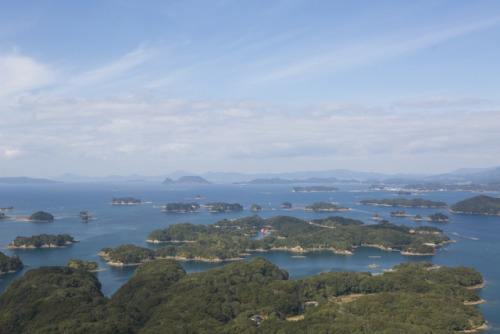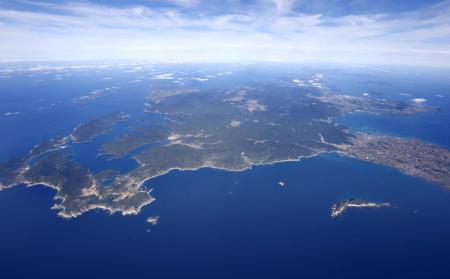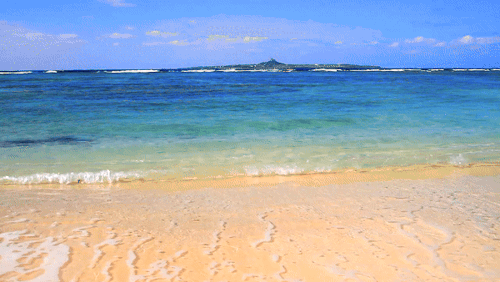Okinawa - Blog Posts





Sean bienvenidos japonistasarqueologos a una nueva entrega, en esta ocasión nos vamos al fondo marino para ver unas de las mayores ruinas arqueológicas que están generando en la comunidad científica muchas controversias desde que fueron descubiertas en 1985. Dicha estructura se encuentra en Okinawa la cual está compuesta por las islas Ryukyu. - Las ruinas tienen unos 10.000 años de antigüedad ¿Hay dos teorías?La primera que dicen los científicos es: que es natural.La segunda es que es artificial.Yo he visto, todo el material registrado hasta el momento en fotos y vídeos para ser sinceros no me parece para nada natural hay puntos en lo que claramente que están trabajados por la mano del hombre. Sí nos imaginamos el montículo fuera de la superficie lo más probable es que se pareciera en su forma natural a una elevación en el terreno y lo más probable es que estuviera en su estado más virgen.-También hay que destacar que el nivel del mal sobre esas fechas era 120 veces más bajo que el actual, por lo que no sería raro que los moradores lo usaran como un lugar sagrado. Ya que para los japoneses el trabajo en roca no es nada nuevo y sobre todo construcciones colosales hechas en piedra como veremos en próximas publicaciones. - Espero que os haya gustado y espero vuestras opiniones y debates sobre el tema que nunca nos va a dejar de sorprender os deseo un feliz dia y una buena semana. - 日本の考古学者は新作を歓迎します。今回は海底に行き、1985年に発見されて以来、科学界で多くの論争を引き起こしている最大の考古学的遺跡の1つを見に行きます。琉球諸島。-遺跡は約1万年前のものですが、2つの説がありますか?科学者が最初に言うことは、それは自然なことだということです。二つ目は、それが人工的であるということです。これまでに写真やビデオに記録されたすべての資料は、正直なところ、私にはまったく自然に見えません。それらが人間の手によって明確に処理されている点があります。地表の外側のマウンドを想像すると、それは自然な形で地面の隆起に似ている可能性が高く、最も手付かずの状態である可能性が最も高いです。-また、当時の悪のレベルは現在の120分の1であったため、住民が聖地として利用することも珍しくありません。日本のロック作品は目新しいものではなく、特に将来の出版物で見られるように石で作られた巨大な構造です。-皆様のご愛顧を賜りますよう、よろしくお願い申し上げます。今後とも変わらぬご意見・ご感想をお待ちしております。 - Welcome japonistaarqueologos to a new installment, this time we go to the seabed to see one of the largest archaeological ruins that are generating many controversies in the scientific community since they were discovered in 1985. This structure is located in Okinawa, which is made up of the Ryukyu Islands. - The ruins are about 10,000 years old. Are there two theories? The first one that scientists say is: that it is natural. The second is that it is artificial. I have seen all the material recorded so far in photos and videos, to be honest, it does not seem natural at all to me. There are points that are clearly worked by the hand of man. If we imagine the mound off the surface, it most likely resembled in its natural form a rise in the ground and most likely it was in its most virgin state. - It should also be noted that the level of evil at that time was 120 times lower than today, so it would not be unusual for the inhabitants to use it as a sacred place. Since for the Japanese, rock work is nothing new and especially colossal constructions made of stone as we will see in future publications. - I hope you liked it and I look forward to your opinions and debates on the subject that will never cease to surprise us. I wish you a happy day and a good week.


Sean bienvenidos japonítasarqueológicos a una nueva entrega en esta ocasión nos desviamos un poco del contenido que suelo hacer, dicho ésto comencemos. - ¿Cómo afectará esto a la arqueológia e historia? ¿Y a la economía? Antes que nada ¿Por qué la situación está así? Esto viene desde el siglo XIX, cuando China sede Taiwán tras perder la Guerra sino-japonesa estará bajo dominio 1895-1945, desde el momento en ese momento se creó la República independiente de China. - Razones por las que China quiere Taiwan: 1°Incorporarla de nuevo a su territorio. 2° Taiwán es la gran exportadora de microchip a nivel mundial. 3° Esto amenazaría el territorio de Japón, ya que las islas de Okinawa está Cerca. Además, china dirá que le están amenazando sus fronteras. - ¿Cómo creéis que afectará a la economía mundial? - Os deseo un cordial saludo y nos vemos en próximas publicaciones de Arqueología e historia japonesa. - 考古学的ジャポナイトは、新しい記事へようこそ。 - これは考古学と歴史にどのように影響しますか? そして経済へ? まず、なぜこのような状況になったのでしょうか。 これは、19 世紀に中国が日中戦争に敗れた後、台湾を占領したときのことであり、独立した中華民国が誕生した瞬間から、1895 年から 1945 年まで台湾は支配下に置かれることになります。 - 中国が台湾を欲しがる理由: 1°テリトリーに戻す。 第 2 位 台湾はマイクロチップの世界最大の輸出国です。 3° 沖縄の島々が近くにあるので、これは日本の領土を脅かすだろう. さらに、中国は国境が脅かされていると言うでしょう。 - 世界経済にどのような影響を与えると思いますか。 - 今後の考古学と日本史の出版物でお会いしましょう。 - Archaeological Japonites are welcome to a new installment, this time we deviate a bit from the content that I usually do, with that said, let's begin. - How will this affect archeology and history? And to the economy? First of all, why is the situation like this? This comes from the 19th century, when China seized Taiwan after losing the Sino-Japanese War, it will be under rule from 1895-1945, from the moment at which the independent Republic of China was created. - Reasons why China wants Taiwan: 1° Incorporate her back into her territory. 2nd Taiwan is the world's largest exporter of microchips. 3° This would threaten the territory of Japan, since the islands of Okinawa are nearby. In addition, China will say that its borders are being threatened. - How do you think it will affect the world economy? - I wish you a cordial greeting and see you in future publications of Archeology and Japanese history.




Sean bienvenidos japonistaarqueológicos, a una nueva actualidad del país del sol naciente. En este caso os comentaré que se han actualizado los datos del número de islas del archipiélago Japonés, dicho esto pónganse cómodos que empezamos. - La información viene de la agencia Geoespacial de Japón, el número de islas son de 14125 en todo el país, más del doble del número anunciado hasta ahora, en 1987 el cálculo era de 6852 islas. - El número de islas en cada prefectura Nagasaki 1479 Hokkaido 1473 Kagoshima 1256 Iwate 861 Okinawa 691. - ¿Qué opinan al respecto? Espero que tengan una buena semana y nos vemos en próximas publicaciones de Japón - 日出づる国から新しいニュースへようこそ。今回は、日本列島の島の数が更新されたことをお伝えします。 - 国土地理院からの情報ですが、日本全国の島の数は14125で、今まで発表されていた数(1987年は6852島)の2倍以上になっています。 - 各都道府県の島嶼数 長崎県 1479 北海道 1473 鹿児島県 1256 岩手県 861 沖縄県 691 - いかがでしょうか?今週も良い一週間をお過ごしください。また、今後の日本からの投稿でお会いしましょう。 - Welcome to a new update from the land of the rising sun. In this case I will tell you that we have updated the data on the number of islands in the Japanese archipelago, so make yourselves comfortable and let's get started. - The information comes from the Geospatial agency of Japan, the number of islands is 14125 in the whole country, more than double the number announced until now, in 1987 the estimate was 6852 islands. - The number of islands in each prefecture Nagasaki 1479 Hokkaido 1473 Kagoshima 1256 Iwate 861 Okinawa 691. - What do you think about it? I hope you have a good week and see you in future posts from Japan.

Ms. Shizuoka Shigato Manale (left) of the Hiroshima Peace Project is wearing a kimono by bingata artist Isa Toshihiko, 1924-2010. The han-eri and tabi that I’m wearing (right) are by bingata artist 染谷 唯 Yui Someya. #japanesetextiles #ryukyu #okinawa #kimonos #kimono #IsaToshihiko #bingata #textiles #haneri tabi

Michihiko Kakazu (National Theater Okinawa), Ichiko Yonamine (Okinawa Prefectural Museum and Art Museum), Toshiaki Hagio (Cultural Assets Division of the Okinawa Prefectural Board of Education), Masayuki Dana (Okinawa Predectural Board of Education), and translators field questions during a symposium for Bingata! Only in Okinawa. Nov. 5, 2016-Jan. 30, 2017. The Textile Museum, Washington, DC. Sponsored by the Okinawa Prefectural Government. Many of the items are national treasures and have never been seen outside of Japan. #bingata #kimono #kimonos #okinawa #ryukyu #japanesetextiles

Michihiko Kakazu of the National Theater Okinawa demonstrates how to put on a woman's Okinawan dance kimono as part of Bingata! Only in Okinawa. Nov. 5, 2016-Jan. 30, 2017. The Textile Museum, Washington, DC. Sponsored by the Okinawa Prefectural Government. Many of the items are national treasures and have never been seen outside of Japan.. #bingata #kimono #kimonos #okinawa #ryukyu #japanesetextiles

Bingata! Only in Okinawa. Nov. 5, 2016-Jan. 30, 2017. The Textile Museum, Washington, DC. Sponsored by the Okinawa Prefectural Government. Many of the items are national treasures and have never been seen outside of Japan. #bingata #kimono #kimonos #okinawa #ryukyu #japanesetextiles

Bingata! Only in Okinawa. Nov. 5, 2016-Jan. 30, 2017. The Textile Museum, Washington, DC. Sponsored by the Okinawa Prefectural Government. Many of the items are national treasures and have never been seen outside of Japan. #bingata #kimono #kimonos #okinawa #ryukyu #japanesetextiles
i love how the mangaka of umibe no etranger (kii kanna) potrays the character AND okinawa. i didnt know b4 that okinawa is that gorgeous 😭 The flowers, trees and the beach ughhhh i wanna go there so badly. but ofc, still, my favorite part is the bois, Hashimoto shun and Chibana mio! 💕 Seeing them laying in their room with opened door, just enjoying okinawan air together... the vibe is immaculate 😭😭 i wanna experience it 😭





Lights and Plants
The Okinawan Language
Anybody who has studied Japanese and Linguistics will know that Japanese is a part of the Japonic language family. For many years it was thought that Japanese was a language isolate, unrelated to any other language (Although there is some debate as to whether or not Japanese and Korean are related). Today, most linguists are in agreement that Japanese is not an isolate. The Japonic languages are split into two groups: Japanese (日本語) and its dialects, which range from standard Eastern Japanese (東日本方言) to the various dialects found on Kyūshū (九州日本方言), which are, different, to say the least. The Ryukyuan Languages (琉球語派). Which are further subdivided into Northern and Southern Ryukyuan languages. Okinawan is classified as a Northern Ryukyuan Languages. There are a total of 6 Ryukyuan languages, each with its own dialects. The Ryukyuan languages exist on a continuum, somebody who speaks Okinawan will have a more difficult time understanding the Yonaguni Language, which is spoken on Japan’s southernmost populated island. Japanese and Okinawan (I am using the Naha dialect of Okinawan because it was the standard language of the Ryukyu Kingdom), are not intelligible. Calling Okinawan a dialect of Japanese is akin to calling Dutch a dialect of English. It is demonstrably false. Furthermore, there is an actual Okinawan dialect of Japanese, which borrows elements from the Okinawan language and infuses it with Japanese. So, where did the Ryukyuan languages come from? This is a question that goes hand in hand with theories about where Ryukyuan people come from. George Kerr, author of Okinawan: The History of an Island People (An old book, but necessary read if you’re interested in Okinawa), theorised that Ryukyuans and Japanese split from the same population, with one group going east to Japan from Korea, whilst the other traveled south to the Ryukyu Islands. “In the language of the Okinawan country people today the north is referred to as nishi, which Iha Fuyu (An Okinawn scholar) derives from inishi (’the past’ or ‘behind’), whereas the Japanese speak of the west as nishi. Iha suggests that in both instances there is preserved an immemorial sense of the direction from which migration took place into the sea islands.” (For those curious, the Okinawan word for ‘west’ is いり [iri]). But, it must be stated that there are multiple theories as to where Ryukyuan and Japanese people came from, some say South-East Asia, some say North Asia, via Korea, some say that it is a mixture of the two. However, this post is solely about language, and whilst the relation between nishi in both languages is intriguing, it is hardly conclusive. With that said, the notion that Proto-Japonic was spoken by migrants from southern Korea is somewhat supported by a number of toponyms that may be of Gaya origin (Or of earlier, unattested origins). However, it also must be said, that such links were used to justify Japanese imperialism in Korea. Yeah, when it comes to Japan and Korea, and their origins, it’s a minefield. What we do know is that a Proto-Japonic language was spoken around Kyūshū, and that it gradually spread throughout Japan and the Ryukyu Islands. The question of when this happened is debatable. Some scholars say between the 2nd and 6th century, others say between the 8th and 9th centuries. The crucial issue here, is the period in which proto-Ryukyuan separated from mainland Japanese. “The crucial issue here is that the period during which the proto-Ryukyuan separated(in terms of historical linguistics) from other Japonic languages do not necessarily coincide with the period during which the proto-Ryukyuan speakers actually settled on the Ryūkyū Islands.That is, it is possible that the proto-Ryukyuan was spoken on south Kyūshū for some time and the proto-Ryukyuan speakers then moved southward to arrive eventually in the Ryūkyū Islands.” This is a theory supported by Iha Fuyu who claimed that the first settlers on Amami were fishermen from Kyūshū. This opens up two possibilities, the first is that ‘Proto-Ryukyuan’ split from ‘Proto-Japonic’, the other is that it split from ‘Old-Japanese’. As we’ll see further, Okinawan actually shares many features with Old Japanese, although these features may have existed before Old-Japanese was spoken. So, what does Okinawan look like? Well, to speakers of Japanese it is recognisable in a few ways. The sentence structure is essentially the same, with a focus on particles, pitch accent, and a subject-object-verb word order. Like Old Japanese, there is a distinction between the terminal form ( 終止形 ) and the attributive form ( 連体形 ). Okinawan also maintains the nominative function of nu ぬ (Japanese: no の). It also retains the sounds ‘wi’ ‘we’ and ‘wo’, which don’t exist in Japanese anymore. Other sounds that don’t exist in Japanese include ‘fa’ ‘fe’ ‘fi’ ‘tu’ and ‘ti’. Some very basic words include: はいさい (Hello, still used in Okinawan Japanese) にふぇーでーびる (Thank you) うちなー (Okinawa) 沖縄口 (Uchinaa-guchi is the word for Okinawan) めんそーれー (Welcome) やまとぅ (Japan, a cognate of やまと, the poetic name for ‘Japan’) Lots of Okinawan can be translated into Japanese word for word. For example, a simple sentence, “Let’s go by bus” バスで行こう (I know, I’m being a little informal haha!) バスっし行ちゃびら (Basu sshi ichabira). As you can see, both sentences are structured the same way. Both have the same loanword for ‘bus’, and both have a particle used to indicate the means by which something is achieved, ‘で’ in Japanese, is ‘っし’ in Okinawan. Another example sentence, “My Japanese isn’t as good as his” 彼より日本語が上手ではない (Kare yori nihon-go ga jouzu dewanai). 彼やか大和口ぬ上手やあらん (Ari yaka yamatu-guchi nu jooji yaaran). Again, they are structured the same way (One important thing to remember about Okinawan romanisation is that long vowels are represented with ‘oo’ ‘aa’ etc. ‘oo’ is pronounced the same as ‘ou’). Of course, this doesn’t work all of the time, if you want to say, “I wrote the letter in Okinawan” 沖縄語で手紙を書いた (Okinawa-go de tegami wo kaita). 沖縄口さーに手紙書ちゃん (Uchinaa-guchi saani tigami kachan). For one, さーに is an alternate version of っし, but, that isn’t the only thing. Okinawan doesn’t have a direct object particle (を in Japanese). In older literary works it was ゆ, but it no longer used in casual speech. Introducing yourself in Okinawan is interesting for a few reasons as well. Let’s say you were introducing yourself to a group. In Japanese you’d say みんなさこんにちは私はフィリクスです (Minna-san konnichiwa watashi ha Felixdesu) ぐすよー我んねーフィリクスでぃいちょいびーん (Gusuyoo wan’nee Felix di ichoibiin). Okinawan has a single word for saying ‘hello’ to a group. It also showcases the topic marker for names and other proper nouns. In Japanese there is only 1, は but Okinawan has 5! や, あー, えー, おー, のー! So, how do you know which to use? Well, there is a rule, typically the particle fuses with short vowels, a → aa, i → ee, u → oo, e → ee, o → oo, n → noo. Of course, the Okinawan pronoun 我ん, is a terrible example, because it is irregular, becoming 我んねー instead of 我んのー or 我んや. Yes. Like Japanese, there are numerous irregularities to pull your hair out over! I hope that this has been interesting for those who have bothered to go through the entire thing. It is important to discuss these languages because most Ryukyuan languages are either ‘definitely’ or ‘critically’ endangered. Mostly due to Japanese assimilation policies from the Meiji period onward, and World War 2. The people of Okinawa are a separate ethnic group, with their own culture, history, poems, songs, dances and languages. It would be a shame to lose something that helps to define a group of people like language does. I may or may not look in the Kyūshū dialects of Japanese next time. I’unno, I just find them interesting.










